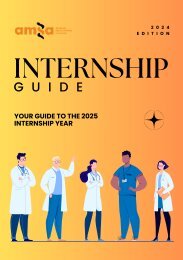AMSA 2023 Internship Guide
UPDATE: Please use the following link to see new updated information from St John of God Healthcare (Western Australia) and Northeast Health (Victoria) https://drive.google.com/file/d/1cMRLLnHZ4YvOyVqwlj2wBdGpIi5bgz3I/view?usp=sharing Hello everyone (especially class of 2023)! The 2023 edition of the AMSA Internship Guide is now available to read! This is the AMSA guide for the 2024 clinical year. This guide could not have been possible without the contribution of medical students, hospital management teams, interns, AMA and many other people volunteering their time to update the information. For example, we have added eight new health networks across all states and territories to the internship guide. Good luck to the class of 2023! We hope that the information within this guide can be beneficial for you during your internship applications. If you have any queries or feedback about the guide, please do not hesitate to email pdo@amsa.org.au.
UPDATE: Please use the following link to see new updated information from St John of God Healthcare (Western Australia) and Northeast Health (Victoria)
https://drive.google.com/file/d/1cMRLLnHZ4YvOyVqwlj2wBdGpIi5bgz3I/view?usp=sharing
Hello everyone (especially class of 2023)! The 2023 edition of the AMSA Internship Guide is now available to read! This is the AMSA guide for the 2024 clinical year.
This guide could not have been possible without the contribution of medical students, hospital management teams, interns, AMA and many other people volunteering their time to update the information. For example, we have added eight new health networks across all states and territories to the internship guide.
Good luck to the class of 2023! We hope that the information within this guide can be beneficial for you during your internship applications.
If you have any queries or feedback about the guide, please do not hesitate to email pdo@amsa.org.au.
Create successful ePaper yourself
Turn your PDF publications into a flip-book with our unique Google optimized e-Paper software.
NETWORK 3:<br />
CONCORD,<br />
CANTERBURY AND<br />
BROKEN HILL<br />
CANTERBURY HOSPITAL<br />
<br />
Canterbury Hospital is an acute general metropolitan district hospital situated 12<br />
km south of Concord Hospital and 15 km SW of the GPO. It is part of the Sydney<br />
Local Health District, which comprises Balmain, Canterbury, Concord, Concord<br />
Centre for Mental Health, Royal Prince Alfred and the Sydney Dental Hospitals.<br />
Canterbury Hospital is a 215-bed metropolitan acute general hospital. Opening in<br />
1929 with 28 beds, it underwent redevelopment in 1998 and its 200 beds covers the<br />
broad scope of Emergency Medicine, General Medicine, ENT Surgery, Urology,<br />
Orthopaedics, Obstetrics and Gynaecology, Paediatrics, Anaesthetics, High<br />
Dependency, Psychiatry, Drug and Alcohol, Aged Care and Rehabilitation and<br />
some outpatient clinics. It is supported by a Hospital in the Home service. Despite<br />
its size, Canterbury Hospital plays an integral role within the local community in the<br />
provision of acute care medicine, with its Emergency Department attending to<br />
over 46,000 presentations, where 25% are paediatric presentations. Canterbury<br />
Hospital plays a significant role in the delivery of maternal services, with a<br />
significantly higher fertility rate than NSW. However, women within its catchment<br />
tend to present later for antenatal care and together with a lower level of<br />
vaccination, suggests there is an overall poorer maternal health profile.<br />
Canterbury Hospital caters for a local population of 220,000 people. The Canterbury<br />
area is home to a culturally and linguistically diverse community. Just under half<br />
(48%) of Canterbury residents were born overseas and just under half (47%)<br />
reported Chinese, Lebanese or Greek ancestry. Many residents of the Canterbury<br />
community have arrived in Australia relatively recently. Just fewer than 67% of<br />
Canterbury residents do not speak English at home which is almost three times<br />
higher than the NSW average (22%). The predominant languages spoken are<br />
Arabic, Greek, Mandarin, Bengali, Cantonese, Vietnamese, Urdu, Italian, Indonesian,<br />
Korean and Nepali. On average, around one third (33%) of Mandarin, Korean,<br />
Cantonese and Vietnamese speakers do not speak English well or at all. The<br />
majority of humanitarian arrivals that have settled in Sydney Local Health District,<br />
have done so in the Canterbury area. Most arrived from Afghanistan, although a<br />
significant number of Burmese and Rohingyan refugees have also settled in the<br />
area. Humanitarian arrivals often have complex health problems related to either<br />
their prior limited access to healthcare or their individual experiences of<br />
persecution or trauma. Aboriginal people make up 1.1% of the district’s population,<br />
compared with 2.9% of the state’s population.

















